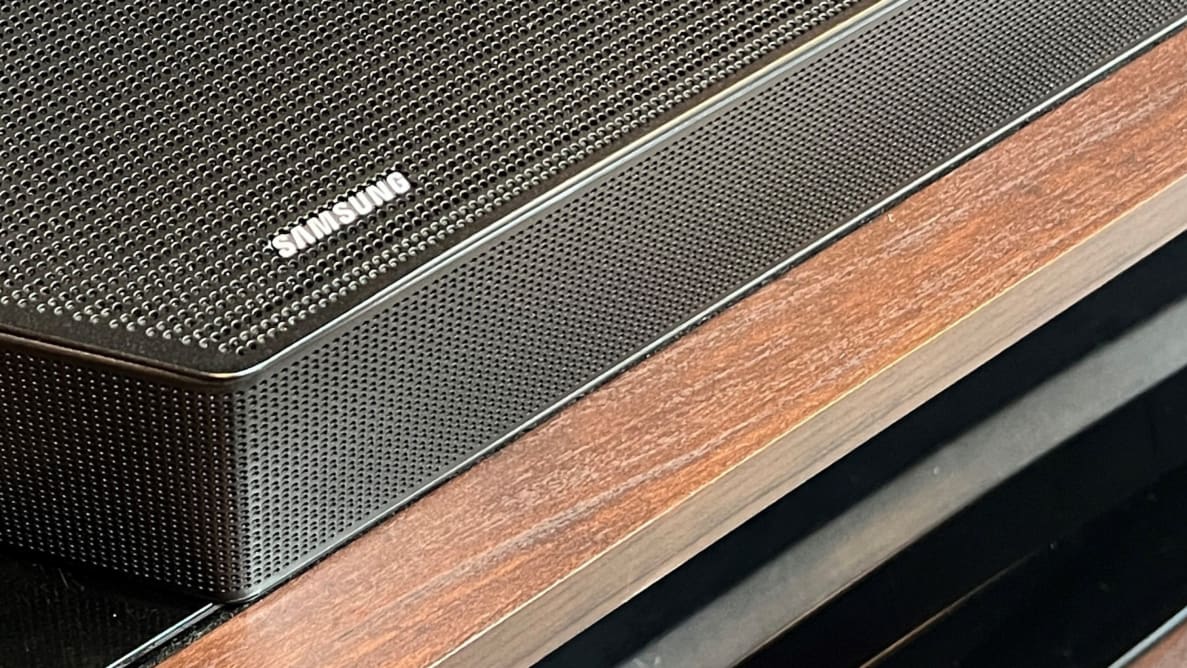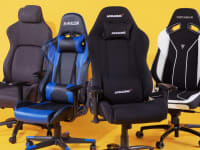Pros
-
Fantastic Dolby Atmos
-
Equal parts power and musicality
-
Easy to adjust
Cons
-
Dodgy Wi-Fi setup
-
No HDMI 2.1 support
While many companies, from Sony to Sonos, have focused their Dolby Atmos tier on single-bar setups that let you build as you go with add-on speakers and subwoofers, bars like Samsung’s HW-Q990B and LG’s S95QR go all in. Both brands offer smaller systems, of course, but if you’re looking for serious immersion from the get-go, you may as well go big.
It doesn’t get much bigger than the Q990B’s 11.1.4-channel configuration which boasts 22 speakers in total, including upfiring and side-firing drivers at the front and back, all powered by over 650 watts. The result is a potent mix of power and seamless surround sound expansion that has yet to be bested by any soundbar I’ve auditioned.
Fall is here, let's get cozy. We're giving away a Solo Stove Bonfire with a stand. Enter to win between now and Nov. 18, 2022.
About the Samsung HW-Q990B
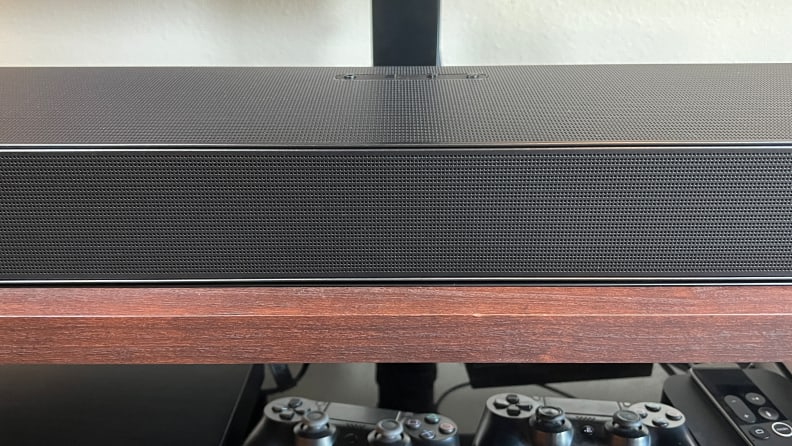
The HW-Q990B offers a scaled-down design and a few new features, but its dimensions are nearly identical to its predecessor.
- Height x Width x Depth: 2.7 x 48.5 x 5.4 inches (soundbar), 16.3 x 8.7 x 16.1 (subwoofer), 7.9 x 5.1 x 5.5 (surrounds)
- Weight: 17 pounds (soundbar), 25.8 pounds (subwoofer), 3.75 pounds (surrounds)
- Speakers/drivers: 22 speakers total; 15 in the bar, three in each surround speaker, one 8-inch subwoofer cone
- Amplification: 656 watts total peak power
- Wireless connection: Wi-Fi (2.5/5GHz), Spotify Connect, AirPlay 2, Bluetooth
- Wired connection: HDMI ARC/eARC, HDMI in (2), digital optical in
- Smart features: Built-in Alexa
- Sound formats: LPCM, Dolby Atmos, Dolby Digital Plus, Dolby TrueHD, DTS:X, DTS 5.1, DTS-HD High Resolution Audio, DTS-HD Master Audio, FLAC, WAV, MP3, AAC, OGG, AIFF
- Video support: 4K/HDR passthrough including Dolby Vision and HDR10+
- Samsung-only features: Samsung Q-Symphony, Wireless Dolby Atmos (only compatible with select 2021/2022 Samsung TVs)
I thought the HW-Q950A was as big as soundbar boxes get, but the Q990B seems somehow bigger. The bar itself is identical in size to its predecessor, while the exterior sheds last year's fabric exterior for an all-black finish. I actually prefer the fabric covering as there’s just not much to hang your hat on here. I do like the subwoofer cabinet’s unquestionably cool new plastic rim, and the snazzy metallic finish to the included satellite speakers evokes a premium feel.
Setting up the system takes some time, and you’ll need ledges or stands for the rear surrounds. As with the previous bar, winding the tight power cables into the otherwise-wireless components is a bit of a pinch. Once done, though, getting sound is as simple as connecting the included cable to your TV’s HDMI ARC or eARC port and pressing power on your TV remote. (Most TVs should be set for remote control of the bar’s main functions by default, but you may need to enable CEC. If your TV only has optical connection you cannot pass Dolby Atmos.)
You’ll also want to download the SmartThings app for Wi-Fi connection which has its quirks we’ll discuss below. The app also unlocks control over most soundbar settings from your phone, as well as setup for features like Amazon Alexa control.
What we like
Transportational Dolby Atmos
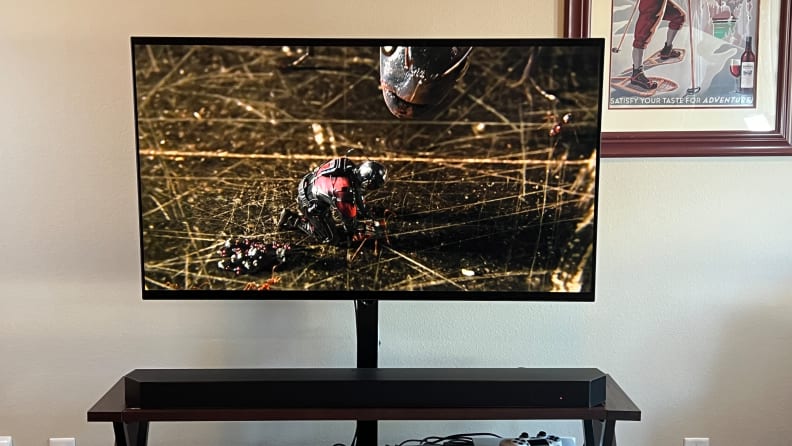
The sound is completely immersive.
You can get a pretty good taste of the overhead effects designed to submerge you in the moment with high-quality standalone Atmos bars like the Sonos Arc, and adding surround speakers or good virtual surround sound effects from soundbars like Sony’s HT-A7000 takes that experience even further. But, as mentioned in my HW-Q950A review, no soundbar system I’ve tried does a better job of dropping you into the sought-after “dome of sound” like Samsung’s 11.1.4-channel system.
You’ll need some good content to get you there, and Disney’s Star Wars series are among the most striking examples I’ve found in streaming land, including the new Andor series. From the moment the first episode began in a disorienting haze of catwalk lights and pouring rain, I had a mile-wide grin across my face. I wasn’t just watching the rain, I was in it, shaking it off with Cassian as he marched toward his destination.
Elsewhere in that same first episode, I found myself tantalizingly close to the flashback fire circle of the outcast children as they planned their assault on some unknown enemy. The forest nestled around me in a palpable atmosphere of chattering creatures and swaying plant life. This is the purpose of all this Dolby Atmos tech, and it’s always sweet to see it pay off in this kind of elemental immersion, with no need to think about anything but the story being told.
Unsurprisingly, I experienced similarly impressive immersion in other Atmos trials, from my favorite Atmos demo disc, to the standout action scenes in Ant-Man. In my favorite action scenes the HW-Q990B made easy work of the thwumping wings of the film’s ant-copters, the thunderous shockwaves of explosions, and the strafing laser fire from Yellowjacket’s menacing suit. This is why we Atmos.
Excellent detail and musicality

The subwoofer seamlessly blends with the bar itself.
The HW-Q990B isn’t just an Atmos ace. Like the Q950A, this bar does quite well souping up all your content. The subtleties of plush soundscapes in series like HBO’s House of Dragons are exceptionally vibrant—I found myself enrapt in simple sounds like the draping fabric as Princess Rhaenyra prepared for her fateful night on the town with Uncle Daemon.
As well as it does with well-produced TV and cinema, one of the most impressive aspects of the HW-Q990B (and its predecessor) is how good it is at balancing those theatrics with solid musical chops. The bar doesn’t have the same tact or overall stereo imaging as my KEF LX 2.1 system, and occasionally moments like sharp brass feel a little thin and forced. But it holds up surprisingly well when compared to full-sized speaker setups—better than the majority of multi-piece Dolby Atmos bars I’ve auditioned.
Using the Standard sound mode (which ditches surround virtualization for the pure audio stream) over Wi-Fi is especially effective, serving up clear and present vocals, rich instrumental timbres, and deep-rooted bass. The subwoofer does an especially good job at naturally blending with the bar itself, especially once you tune it with the included Auto EQ. That’s a notable weakness of many a soundbar-sub combo, and again evokes that word: “seamless.”
There are some annoyances that come along with streaming audio from methods like Spotify Connect, which I’ll touch on below, and I wish the Bluetooth streaming came at higher quality than SBC. But when it comes to clear and full Wi-Fi audio quality, the HW-Q990B is a stand-out performer. As with most bars in its class, there’s even support for high-resolution audio files.
A bountiful surround sound buffet
Soundbars from brands like Sonos and Bose give short shrift to lesser-used sound formats like DTS, including the biggest Dolby Atmos rival, DTS:X. But the HW-Q990B joins rivals from Sony and LG in supporting a font of formats from both DTS and Dolby. This means you’ll be able to get the best out of every medium, from your favorite streaming series to that aging Lord of the Rings Blu-ray box-set you can’t yet bear to part with.
The front display returns
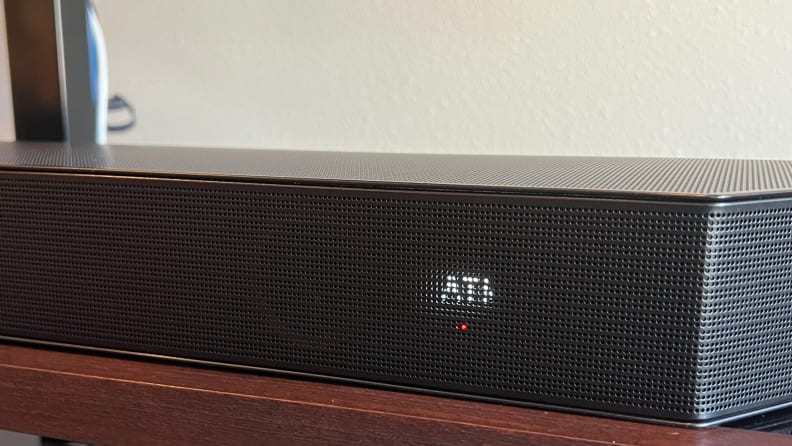
Samsung thankfully placed the digital display in the front for this bar.
After the head-scratching move of placing the digital display on top of the HW-Q950 where no one but your ceiling spiders could see it, Samsung thankfully returned the display to the soundbar’s front right corner. While it’s a little small, it does the trick, allowing you to quickly see which input you’re using and sound formats like Dolby Atmos, as well as making settings changes with the included remote for things like basic EQ and even channel levels.
Simplified A/V integration
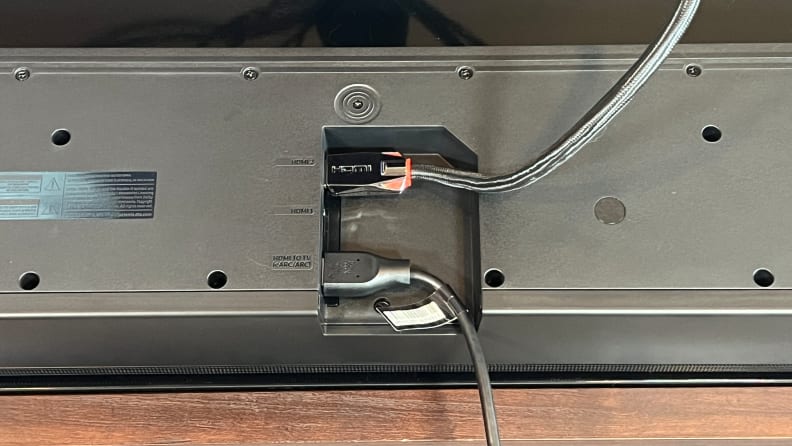
Integrating the bar with most setups is easy.
Alongside its loaded suite of surround formats, the bar is easy to integrate into most setups. I had a couple of issues with my LG C1 OLED failing to turn the bar on, but for the most part everything just worked. Inputs change automatically, but also allow for manual override, such as allowing you to stream audio over Wi-Fi even when the TV is sending a signal over HDMI.
Thanks to dual HDMI inputs with 4K/HDR passthrough, as well as eARC to source full-resolution audio from newer TVs, the Q990B makes it easy to decode audio from any source. Now that TV brands like LG have abandoned DTS support, the extra inputs are increasingly useful, though Samsung’s lack of support for HDMI 2.1 features like 4K @ 120Hz puts it a step behind Sony's HT-A7000 system for gaming.
Unlike Sony’s bar, though, Samsung’s SmartThings app lets you adjust virtually all settings—from channel levels and a 7-band EQ to audio streaming—from your phone. That’s a good thing since the Q990B’s primary auto-calibration feature, SpaceFit+, requires you keep the microphone on all the time for daily frequency adjustments instead of a one-time measurement. It’s an interesting idea, but not a great option for those who want to assure privacy.
What we don’t like
Wi-Fi setup and Spotify are clunky
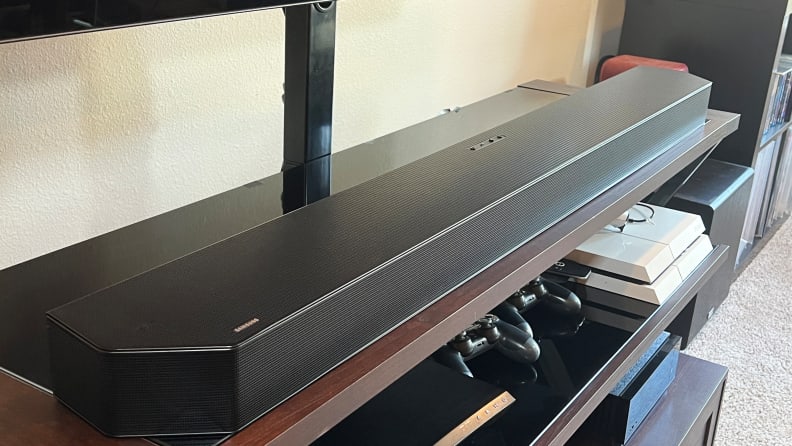
Connecting the system over Wi-Fi can be a headache.
While SmartThings continues to improve, connecting the system over Wi-Fi is simultaneously one of the most important and most frustrating parts of the experience. Unlike Sonos, where a button on top almost instantly gets you connected, I had to go through five tries over two days before I got SmartThings to connect to the bar and find my network. Others have reported similar issues, and while Samsung isn’t alone here, brands like Sonos and Bose show things can be much easier. Samsung needs to fix the stalls, and put a backup in place, too.
Otherwise, SmartThings works quite well, with the exception of Spotify Connect. The good news is I didn’t have any stutters streaming over Wi-Fi in over a week, which is noteworthy in this space. But controlling volume in Spotify or directly in SmartThings is sensitive and difficult to adjust without making audio too quiet or too loud. There’s only a single fader inside the app for volume (no plus or minus buttons) and moving it without blasting the room is very tricky.
AirPlay with my iPhone 13 Pro was much easier to control—I could easily adjust volume from the phone’s side buttons without overcorrection. Spotify Connect needs work.
Next-gen gaming is cut short
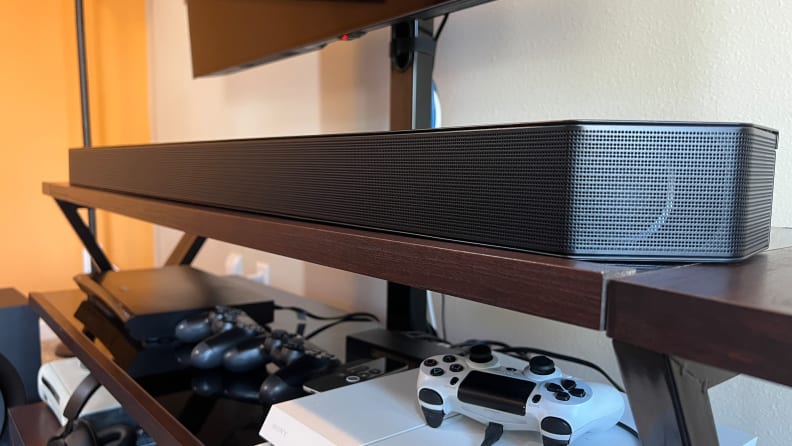
The bar doesn't support 120Hz frame rates which would make it optimal for next-gen gamers.
Unlike Sony’s latest bars, including the HT-A7000 and the cheaper HT-A5000, Samsung’s latest bar does not include HDMI 2.1 features like 4K passthrough at 120Hz. As touched on above, this limits your ability to game at high frame rates when connecting a console directly. I don’t expect this to matter to most folks, as it’s more of a future-proofing feature that requires a top-tier TV and games that take advantage, but we’d still have liked to see it supported for this update.
Samsung-only features
One of the HW-Q990B’s most intriguing new features, wireless connection for Dolby Atmos, is out for anyone who hasn’t bought a pricey Samsung TV recently. The same goes for Samsung’s Q-Symphony feature that utilizes the TV and soundbar in harmony for better on-screen audio orientation. It’s understandable, given the constraints of other manufacturers, but it’d be nice if at least wireless connection worked with any modern TV via a dongle or similar setup.
Should you buy the Samsung HW-Q990B?
Yes, if you’re willing to invest in top-tier Dolby Atmos
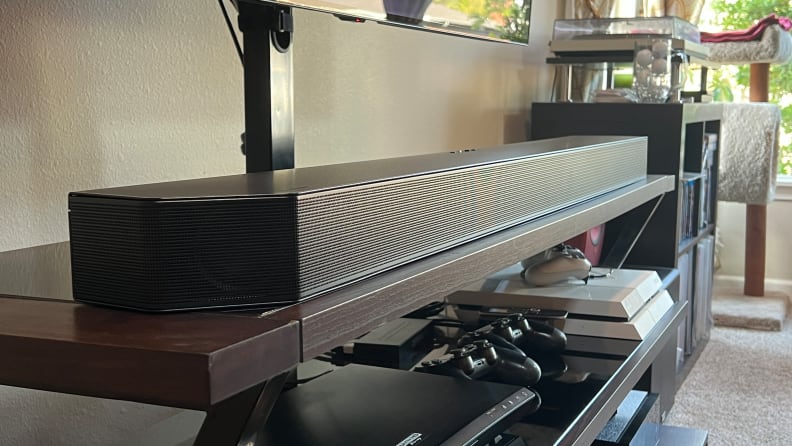
This soundbar is the cream of the crop of Dolby Atmos experiences.
Samsung’s latest 11.1.4-channel bomber is once again among the very best Dolby Atmos experiences you can get without rearranging the furniture (much). It’s stunningly immersive, loaded with details, and offers excellent musicality and balance across all mediums. It’s also relatively easy to use and adjust—once you get SmartThings up and running, that is. This obviously isn't an upgrade situation for those with the Q950A, but this will be the new top bar in the lineup.
If you’re looking for a cheaper alternative, our favorite backup option right now is still the original Vizio Elevate soundbar, which offers a solid swath of the features and cinematic punch Samsung’s bar serves up at a much lower price. It’s not as good for music and it’s not as immersive as Samsung’s bar either, but it saves serious cash. We’re also testing LG’s S95QR soon, which has fewer drivers, but should theoretically give Samsung’s bar a good run for the money.
Sony’s HT-A7000 is another good alternative, especially if you’re interested in next-gen gaming and/or a simpler setup, but you’ll pay a lot more for surround speakers and a subwoofer, and you still won’t get upfiring speakers for the back of your listening space. At that point (and even before), you start getting into a similar cost to a fully decked out A/V system from solid brands like SVS’ Prime series.
If you want a big dawg when it comes to Dolby Atmos soundbars, and you’re willing to pay for it, it’s hard to imagine doing much better than Samsung’s HW-Q990B. Like the Q950A before it, this bar offers a sweet blend of thrilling power and balanced musicality to make for a great sonic centerpiece. And if you can catch it on sale, you’re actually getting a fair bit for your money.
The product experts at Reviewed have all your shopping needs covered. Follow Reviewed on Facebook, Twitter, Instagram, TikTok, or Flipboard for the latest deals, product reviews, and more.
Prices were accurate at the time this article was published but may change over time.
Meet the tester
Hailing originally from Montana, Ryan parlayed his time working as a musician and audio engineer into a career in digital media in 2012. Since then he's had extensive experience as a writer and editor, including everything from op-eds and features to reviews on TVs, audio gear, smart home devices, and more.
Checking our work.
Our team is here to help you buy the best stuff and love what you own. Our writers, editors, and experts obsess over the products we cover to make sure you're confident and satisfied. Have a different opinion about something we recommend? Email us and we'll compare notes.
Shoot us an email

